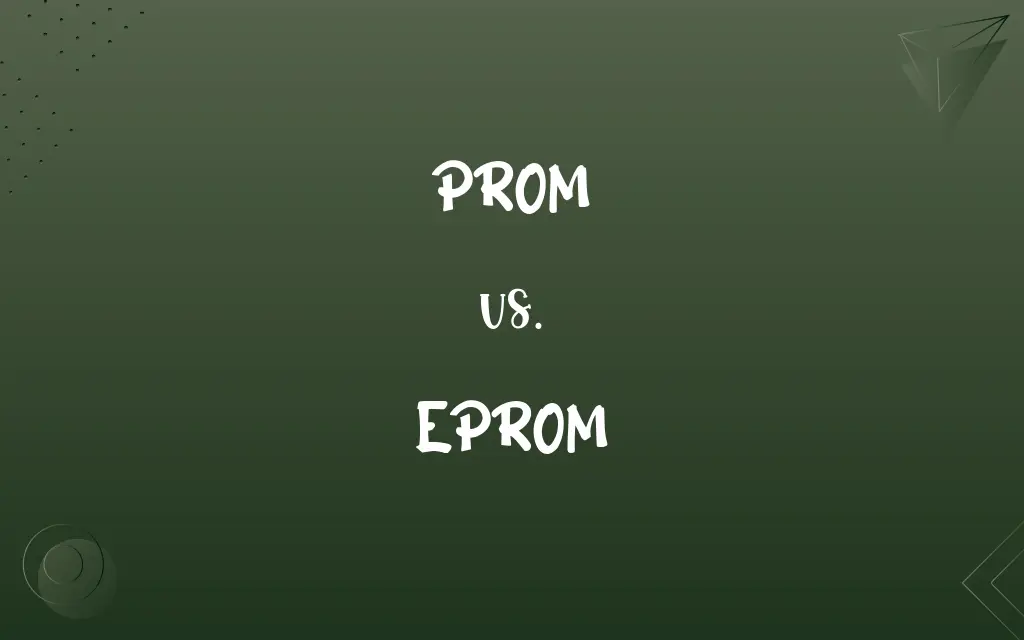PROM vs. EPROM: Know the Difference

By Hifza Nasir & Shumaila Saeed || Published on March 4, 2024
PROM (Programmable Read-Only Memory) is write-once memory; data is permanent. EPROM (Erasable Programmable Read-Only Memory) can be erased with UV light and reprogrammed.

Key Differences
PROM, or Programmable Read-Only Memory, is a type of non-volatile memory where data is written once and becomes permanent; the process is known as "burning" or "programming." It's used in applications where the need for data storage is permanent and unchanging, such as in firmware. EPROM, or Erasable Programmable Read-Only Memory, on the other hand, introduces flexibility to the programming process. Data stored in EPROM can be erased by exposing the chip to ultraviolet (UV) light for a certain period, after which it can be reprogrammed. This erasable feature makes EPROM suitable for development, testing, and updating firmware where changes might be needed.
Shumaila Saeed
Mar 04, 2024
One key distinction between the two is their approach to data permanence and reusability. PROM is designed for a single-use scenario where the integrity and permanence of the data are critical. In contrast, EPROM provides a reusability feature that is invaluable during the development phase of a project, allowing developers to test and modify their code.
Hifza Nasir
Mar 04, 2024
The physical appearance of EPROM is distinctive, with a transparent quartz window on top of the chip, which allows the UV light to penetrate and erase the data. PROM chips lack this window since they are not designed to be erased. This window is not only a physical differentiator but also a symbol of the fundamental difference in the use of the two types of memories.
Shumaila Saeed
Mar 04, 2024
PROM is often found in older or more traditional devices where the programming is known to be static and unchanging, such as in simple electronic devices or older computer BIOS systems. EPROM, while still used in similar contexts, is more aligned with environments that require periodic updates or where the development cycle includes testing and iteration, such as in prototype electronics or early-stage software/hardware integration.
Hifza Nasir
Mar 04, 2024
Despite the advantages of reusability offered by EPROM, the advent of Electrically Erasable Programmable Read-Only Memory (EEPROM) and Flash memory has led to a decline in the use of both PROM and EPROM. These newer technologies allow for data to be erased and rewritten without the need for UV light, providing even greater flexibility and convenience.
Dua Fatima
Mar 04, 2024
ADVERTISEMENT
Comparison Chart
Physical Characteristic
No transparent window
Transparent quartz window for UV erasure
Hifza Nasir
Mar 04, 2024
Use Cases
Applications requiring permanent data storage
Development, testing, and environments requiring data updates
Shumaila Saeed
Mar 04, 2024
Flexibility
None; data is permanent after programming
High; data can be erased and updated as needed
Hifza Nasir
Mar 04, 2024
ADVERTISEMENT
Technology Era
Predominantly older, legacy systems
Used before the widespread adoption of EEPROM and Flash memory
Shumaila Saeed
Mar 04, 2024
PROM and EPROM Definitions
PROM
A non-volatile memory chip where data, once written, is permanent.
Storing the firmware in a microwave oven that doesn't require updates.
Shumaila Saeed
Feb 26, 2024
EPROM
A type of memory chip that can be erased using UV light and reprogrammed.
Prototyping electronic circuits where code frequently changes.
Hifza Nasir
Feb 26, 2024
PROM
Used for permanent storage of program code.
Basic input/output system (BIOS) settings in early computers.
Hifza Nasir
Feb 26, 2024
ADVERTISEMENT
EPROM
Features a quartz window through which UV light erases data.
Testing and development phases of embedded system design.
Shumaila Saeed
Feb 26, 2024
PROM
Ideal for applications where data integrity and permanence are crucial.
Code storage in calculators.
Dua Fatima
Feb 26, 2024
EPROM
Allows for iterative testing and updating of stored data.
Updating the firmware in legacy computer systems.
Dua Fatima
Feb 26, 2024
PROM
Programming is irreversible, preventing accidental data loss.
Embedded systems in industrial machinery.
Shumaila Saeed
Feb 26, 2024
EPROM
Reusability makes it adaptable for evolving project requirements.
Aerospace applications where software updates are critical.
Hifza Nasir
Feb 26, 2024
PROM
Suited for mass-produced items with fixed functionalities.
Electronic toys with pre-programmed sounds or actions.
Dua Fatima
Feb 26, 2024
EPROM
Used in environments where flexibility and data updation are key.
Experimental labs testing different firmware versions.
Shumaila Saeed
Feb 26, 2024
PROM
A kind of read-only memory whose contents can be set after manufacture, but only once.
Hifza Nasir
Jan 25, 2024
Repeatedly Asked Queries
How can data in an EPROM be erased?
Data in an EPROM can be erased by exposing the chip to ultraviolet light through its quartz window, usually for a specified duration.
Hifza Nasir
Mar 04, 2024
What is PROM used for?
PROM is used for storing data permanently in applications where the information does not need to be changed, such as in firmware for various electronic devices.
Shumaila Saeed
Mar 04, 2024
What makes EPROM suitable for development and testing?
EPROM's ability to be erased and reprogrammed makes it highly suitable for iterative development processes, allowing for testing and modification of code.
Hifza Nasir
Mar 04, 2024
Can EPROM be used for permanent data storage?
While EPROM can be used for permanent data storage, its real advantage is in its reusability, making it more suitable for situations where data may need to be updated.
Shumaila Saeed
Mar 04, 2024
What has replaced PROM and EPROM in modern applications?
EEPROM and Flash memory have largely replaced PROM and EPROM, offering electric erasure and reprogramming capabilities without the need for UV light.
Dua Fatima
Mar 04, 2024
How does the programming process differ between PROM and EPROM?
PROM is programmed using a special device that 'burns' the data into the chip, making it permanent. EPROM is programmed in a similar way but can be erased and reprogrammed.
Shumaila Saeed
Mar 04, 2024
How does the physical appearance of PROM and EPROM differ?
EPROM chips have a distinctive transparent quartz window on top for UV erasure, while PROM chips do not have such a window due to their permanent programming nature.
Hifza Nasir
Mar 04, 2024
Are PROM chips reusable?
No, PROM chips are designed for a single use; once programmed, the data becomes permanent and cannot be altered or erased.
Shumaila Saeed
Mar 04, 2024
Is there a way to protect EPROM from accidental erasure?
EPROMs are typically covered with a sticker or label to protect the quartz window from accidental exposure to UV light, preventing unintended erasure.
Hifza Nasir
Mar 04, 2024
What are the environmental considerations for using EPROM?
Since EPROM requires UV light for data erasure, proper handling and protection against accidental UV exposure are important to maintain data integrity.
Hifza Nasir
Mar 04, 2024
Share this page
Link for your blog / website
HTML
Link to share via messenger
About Author
Written by
Hifza NasirCo-written by
Shumaila SaeedShumaila Saeed, an expert content creator with 6 years of experience, specializes in distilling complex topics into easily digestible comparisons, shining a light on the nuances that both inform and educate readers with clarity and accuracy.






































































